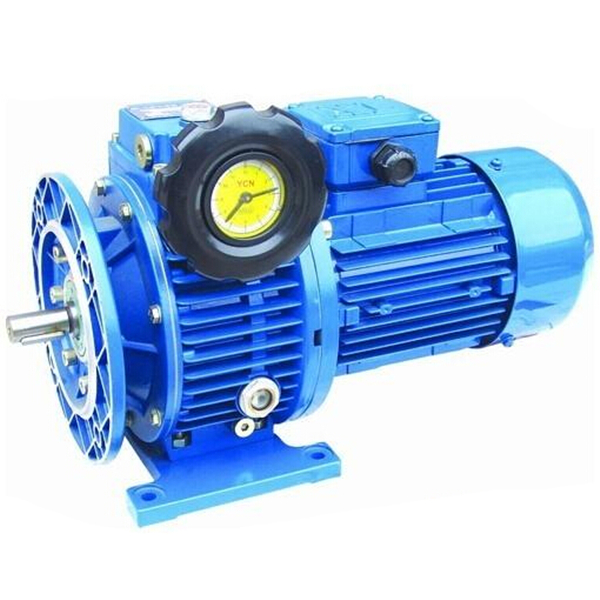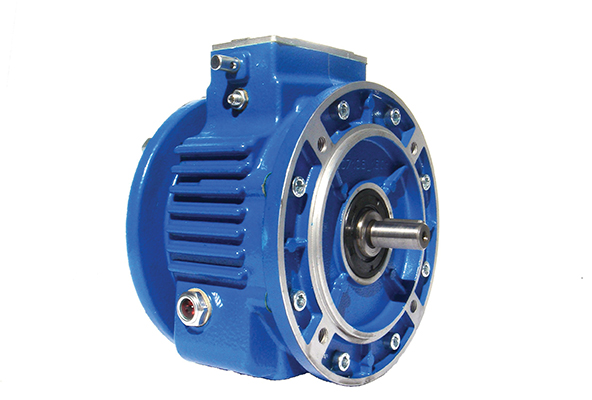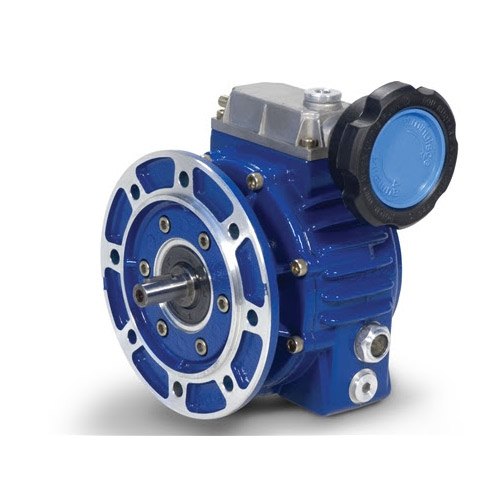Product Description
JWB Series Speed Variator
1. Features:
JWB-X type
- Sizes: ≥04
- Power up to 1.5 kW or more
- Cases in RAL 5571 blue cast iron
- Shafts: case hardened and tempered steel.
- Internal components: heat-treated steel
- Output speed with 4 pole(1400r/min) motors: 2-10r/min;4.7-23.5r/min;15-75r/min;20-100r/min, 28-140r/min, 30-150r/min;40-200r/min;60-300r/min;80-400r/min;100-500r/min;190-950r/min.
- Output Torque value max 1002Nm
- Silent, vibration-free running
- Bidirectional rotation
- Control handwheel positionable on either side
- Slipping speed to max load at 5%
- Regulation sensibility: 0,5 rpm
- Painted with blue epoxy-polyester powder
JWB-X B type
- Sizes:01,02,03 and 04
- Power up to 1.5 kW or less
- Cases in die-cast aluminium alloy
- Shafts: case hardened and tempered steel.
- Internal components: heat-treated steel
- Output speed with 4 pole(1400r/min) motors: 2r/min-20r/min;4.7r/min-23.5r/min;6.5-32.5r/min, 8-40r/min, 9-45r/min, 13-65r/min, 15r/min-75r/min;18-90r/min, 25-125r/min, 28r/min-140r/min;40r/min-200r/min;60r/min-300r/min;80r/min-400r/min;100r/min-500r/min;190r/min-950r/min.
- Output Torque value max 795 Nm
- Silent, vibration-free running
- Bidirectional rotation
- Control hand wheel positionable on either side
- Slipping speed to max load at 5%
- Regulation sensibility: 0,5 rpm
- Painted with blue epoxy-polyester powder
2. Technical parameters
| Type | Output Torque | Output Shaft Dia. | Output Speed Range | 2rpm-950rpm | |
| SWB01 | 2.6-1.6N.m | φ11 | Applicable Motor Power | 0.18kW-7.5kW | |
| SWB02 | 258-1.8N.m | φ14,φ24,φ28,φ32 | |||
| SWB03 | 426-4N.m | φ24,φ28,φ38 | Input Options | With Inline AC Motor | |
| SWB04 | 795-8N.m | φ28,φ38,φ42 | With IEC Motor | ||
| SWB05 | 535-16N.m | φ38,φ48,φ55 | With Input Shaft | ||
| SWB06 | 1002-40N.m | φ42,φ55,φ70 | With Input Flange | ||
About Us
ZheJiang CHINAMFG Drive Co.,Ltd,the predecessor was a state-owned mould enterprise, was established in 1965. CHINAMFG specializes in the complete power transmission solution for high-end equipment manufacturing industries based on the aim of "Platform Product, Application Design and Professional Service".
Starshine have a strong technical force with over 350 employees at present, including over 30 engineering technicians, 30 quality inspectors, covering an area of 80000 square CHINAMFG and kinds of advanced processing machines and testing equipments. We have a good foundation for the industry application development and service of high-end speed reducers & variators owning to the provincial engineering technology research center,the lab of gear speed reducers, and the base of modern R&D.
Our Team
Quality Control
Quality:Insist on Improvement,Strive for Excellence With the development of equipment manufacturing indurstry,customer never satirsfy with the current quality of our products,on the contrary,wcreate the value of quality.
Quality policy:to enhance the overall level in the field of power transmission
Quality View:Continuous Improvement , pursuit of excellence
Quality Philosophy:Quality creates value
3. Incoming Quality Control
To establish the AQL acceptable level of incoming material control, to provide the material for the whole inspection, sampling, immunity. On the acceptance of qualified products to warehousing, substandard goods to take return, check, rework, rework inspection; responsible for tracking bad, to monitor the supplier to take corrective
measures to prevent recurrence.
4. Process Quality Control
The manufacturing site of the first examination, inspection and final inspection, sampling according to the requirements of some projects, judging the quality change trend;
found abnormal phenomenon of manufacturing, and supervise the production department to improve, eliminate the abnormal phenomenon or state.
5. FQC(Final QC)
After the manufacturing department will complete the product, stand in the customer's position on the finished product quality verification, in order to ensure the quality of
customer expectations and needs.
6. OQC(Outgoing QC)
After the product sample inspection to determine the qualified, allowing storage, but when the finished product from the warehouse before the formal delivery of the goods, there is a check, this is called the shipment inspection.Check content:In the warehouse storage and transfer status to confirm, while confirming the delivery of the
product is a product inspection to determine the qualified products.
7. Certification.
Packing
Delivery
/* January 22, 2571 19:08:37 */!function(){function s(e,r){var a,o={};try{e&&e.split(",").forEach(function(e,t){e&&(a=e.match(/(.*?):(.*)$/))&&1
| Application: | Motor, Machinery, Agricultural Machinery |
|---|---|
| Function: | Speed Changing, Speed Reduction |
| Layout: | Coaxial |
| Hardness: | Hardened Tooth Surface |
| Installation: | Horizontal Type |
| Step: | Stepless |
| Customization: |
Available
|
|
|---|
How does the design of variators contribute to energy savings and reduced emissions?
Variators are designed with several key features and mechanisms that contribute to energy savings and reduced emissions. These design aspects focus on optimizing power transmission efficiency, reducing mechanical losses, and enabling better control over the powertrain. Here's a detailed explanation of how the design of variators contributes to energy savings and reduced emissions:
1. Continuously Variable Transmission (CVT) Design:
Variators, particularly those used in CVTs, offer a continuously variable gear ratio, allowing the engine to operate at its most efficient speed for a given driving condition. Unlike traditional transmissions with fixed gear ratios, CVTs enable the engine to stay within its optimal power band, resulting in improved fuel efficiency. The continuously variable nature of CVTs ensures that the engine can maintain an optimal RPM (revolutions per minute) regardless of the vehicle speed, reducing unnecessary fuel consumption and emissions.
2. Friction Reduction:
Variators are designed to minimize friction and mechanical losses in the power transmission system. Friction reduction measures, such as the use of low-friction materials, improved lubrication systems, and optimized bearing designs, help to minimize energy losses during power transmission. By reducing friction, variators improve the overall efficiency of the powertrain, allowing more energy from the engine to be effectively transferred to the wheels or driven machinery, resulting in energy savings and reduced emissions.
3. Lightweight Construction:
The design of variators focuses on lightweight construction using materials that offer high strength and durability. By reducing the weight of variators, the overall weight of the vehicle or machinery can be reduced. A lighter vehicle or machinery requires less energy to accelerate, decelerate, and operate, resulting in improved energy efficiency. Additionally, lighter components in variators also contribute to reduced mechanical losses and improved overall system efficiency.
4. Efficient Power Flow:
Variators are designed to ensure efficient power flow from the engine to the wheels or driven machinery. They are engineered to minimize power losses during transmission, ensuring that a maximum amount of power is delivered to the wheels or machinery. By optimizing power flow, variators help to reduce energy waste and improve overall energy efficiency, resulting in energy savings and reduced emissions.
5. Advanced Control Systems:
Modern variators often incorporate advanced control systems that optimize power delivery and engine operation. These control systems continuously monitor various parameters, such as throttle input, vehicle speed, and engine load, and adjust the gear ratio accordingly. By precisely controlling the powertrain, variators help to minimize unnecessary fuel consumption and emissions. Additionally, advanced control systems can also facilitate regenerative braking and energy recovery, further enhancing energy savings and reducing emissions.
6. Integration with Hybrid and Electric Powertrains:
Variators are designed to integrate seamlessly with hybrid and electric powertrains. In hybrid vehicles, variators play a crucial role in efficiently transferring power between the internal combustion engine and the electric motor. They enable smooth transitions between different power sources, optimizing energy usage and reducing emissions. In electric vehicles, variators are often used in conjunction with single-speed transmissions to provide efficient power delivery from the electric motor to the wheels, contributing to energy savings and reduced emissions.
7. Compliance with Emission Regulations:
The design of variators takes into account emission regulations and standards imposed by regulatory bodies. Manufacturers ensure that variators meet or exceed these regulations by incorporating features that minimize emissions and improve fuel efficiency. This includes optimizing gear ratios for reduced fuel consumption, implementing efficient control systems, and utilizing technologies such as regenerative braking and energy recovery. By complying with emission regulations, variators contribute to reduced emissions and environmental impact.
In conclusion, the design of variators incorporates features that optimize power transmission efficiency, reduce mechanical losses, and enable better control over the powertrain. These design aspects, such as continuously variable transmission design, friction reduction, lightweight construction, efficient power flow, advanced control systems, integration with hybrid/electric powertrains, and compliance with emission regulations, contribute to energy savings and reduced emissions. By improving overall system efficiency and optimizing power delivery, variators play a significant role in achieving energy efficiency and environmental sustainability in vehicles and machinery.
Can you provide insights into the importance of proper variator alignment?
Proper variator alignment is of utmost importance for the optimal performance and longevity of variator systems. The alignment refers to the precise positioning and alignment of the variator components, including the drive and driven pulleys, belts, and associated hardware. Here are some insights into the importance of proper variator alignment:
1. Efficient Power Transfer:
Proper variator alignment ensures efficient power transfer from the engine to the driven wheels. When the variator components are properly aligned, there is minimal power loss due to misalignment or slippage. This efficient power transfer allows the vehicle to operate at its maximum performance potential, providing better acceleration, smoother shifts, and improved fuel efficiency.
2. Optimal Belt Performance:
Variators rely on belts to transmit power between the drive and driven pulleys. Proper alignment ensures that the belts operate within their designed specifications. Misalignment can cause the belts to run off-center or at an angle, leading to increased wear, premature belt failure, and reduced overall performance. Aligning the variator components correctly ensures that the belts are properly tensioned and positioned, maximizing their lifespan and performance.
3. Reduced Wear and Tear:
Misalignment can result in excessive friction, heat buildup, and increased wear on the variator components. The misaligned pulleys and belts can cause uneven distribution of forces and place additional stress on the bearings, shafts, and other mechanical parts. Over time, this can lead to accelerated wear, premature failure of components, and costly repairs. Proper variator alignment helps minimize these issues, reducing wear and tear and increasing the lifespan of the system.
4. Smooth Operation:
Proper alignment contributes to smooth and seamless operation of the variator system. When the variator components are aligned correctly, the gear ratio changes occur smoothly without jerks or vibrations. This smooth operation improves the overall driving experience, ensuring comfortable shifts and consistent power delivery. Misalignment can result in erratic behavior, such as belt slippage, juddering, or sudden changes in power output, compromising the vehicle's performance and drivability.
5. Prevents Excessive Noise and Vibration:
Misaligned variator components can generate excessive noise and vibration during operation. The misalignment can cause the belts to rub against the pulleys, leading to squealing or chirping noises. In addition, vibrations may occur due to the imbalanced forces generated by misaligned components. Proper variator alignment helps minimize these noise and vibration issues, ensuring a quieter and smoother operation of the system.
6. Avoids Premature Component Failure:
Misalignment places undue stress on the variator components, increasing the risk of premature failure. Bearings, shafts, pulleys, and other mechanical parts can experience excessive wear, fatigue, or damage when subjected to misalignment-related forces. By aligning the variator components correctly, the load is distributed evenly, reducing the risk of premature failure and extending the lifespan of the system.
7. Consistent Performance and Efficiency:
Proper variator alignment ensures consistent performance and efficiency throughout the lifespan of the system. When the components are aligned correctly, the variator operates as intended, delivering consistent gear shifts, power delivery, and fuel efficiency. Consistency in performance and efficiency is vital for a reliable and enjoyable driving experience.
In conclusion, proper variator alignment is essential for the optimal performance, longevity, and reliability of variator systems. It ensures efficient power transfer, optimal belt performance, reduced wear and tear, smooth operation, minimized noise and vibration, avoidance of premature component failure, and consistent performance and efficiency. Regular inspection and maintenance, along with professional alignment when necessary, are crucial to maintaining proper variator alignment and maximizing the benefits of the system.
What is a variator, and how does it function in mechanical systems?
A variator is a mechanical device used in certain systems to provide variable speed or torque output. It is commonly found in applications such as belt-driven continuously variable transmissions (CVTs) and hydraulic systems. A variator allows for seamless and continuous adjustment of output speed or torque within a specific range, without the need for discrete gears or speed ratios. Here's a detailed explanation of what a variator is and how it functions in mechanical systems:
A variator typically consists of two primary components: a driving element and a driven element. The driving element is connected to the power source, while the driven element is connected to the load or output. The two elements are linked together through a set of movable parts, such as adjustable sheaves, cones, or pistons.
The function of a variator is to vary the effective diameter or contact ratio between the driving and driven elements. By changing the effective diameter, the output speed or torque can be adjusted continuously. The specific mechanism employed by a variator depends on its design and application, but the basic principle remains the same.
In a belt-driven CVT variator, for example, the driving element consists of two variable-diameter pulleys connected by a belt. The pulleys have movable sheaves that can adjust their effective diameter. By changing the position of the sheaves, the belt rides at different points on the pulleys, effectively changing the gear ratio and allowing for continuous speed variation. When the driving pulley's effective diameter increases, the belt rides higher on the pulley, resulting in a larger output speed. Conversely, when the driving pulley's effective diameter decreases, the belt rides lower, resulting in a smaller output speed.
In hydraulic systems, a variator can be achieved through the use of adjustable flow control valves or variable-displacement pumps. By adjusting the valve position or pump displacement, the flow rate and speed of the hydraulic fluid can be varied, enabling precise control of the output speed and torque.
Overall, the variator's function in mechanical systems is to provide a continuously variable output by adjusting the effective diameter, contact ratio, or flow rate. This enables smooth and seamless speed or torque variation without the need for discrete gears or speed ratios. Variators offer advantages such as improved efficiency, flexibility, and precise control in various applications, including automotive transmissions, industrial machinery, and hydraulic systems.
editor by CX 2024-04-09





